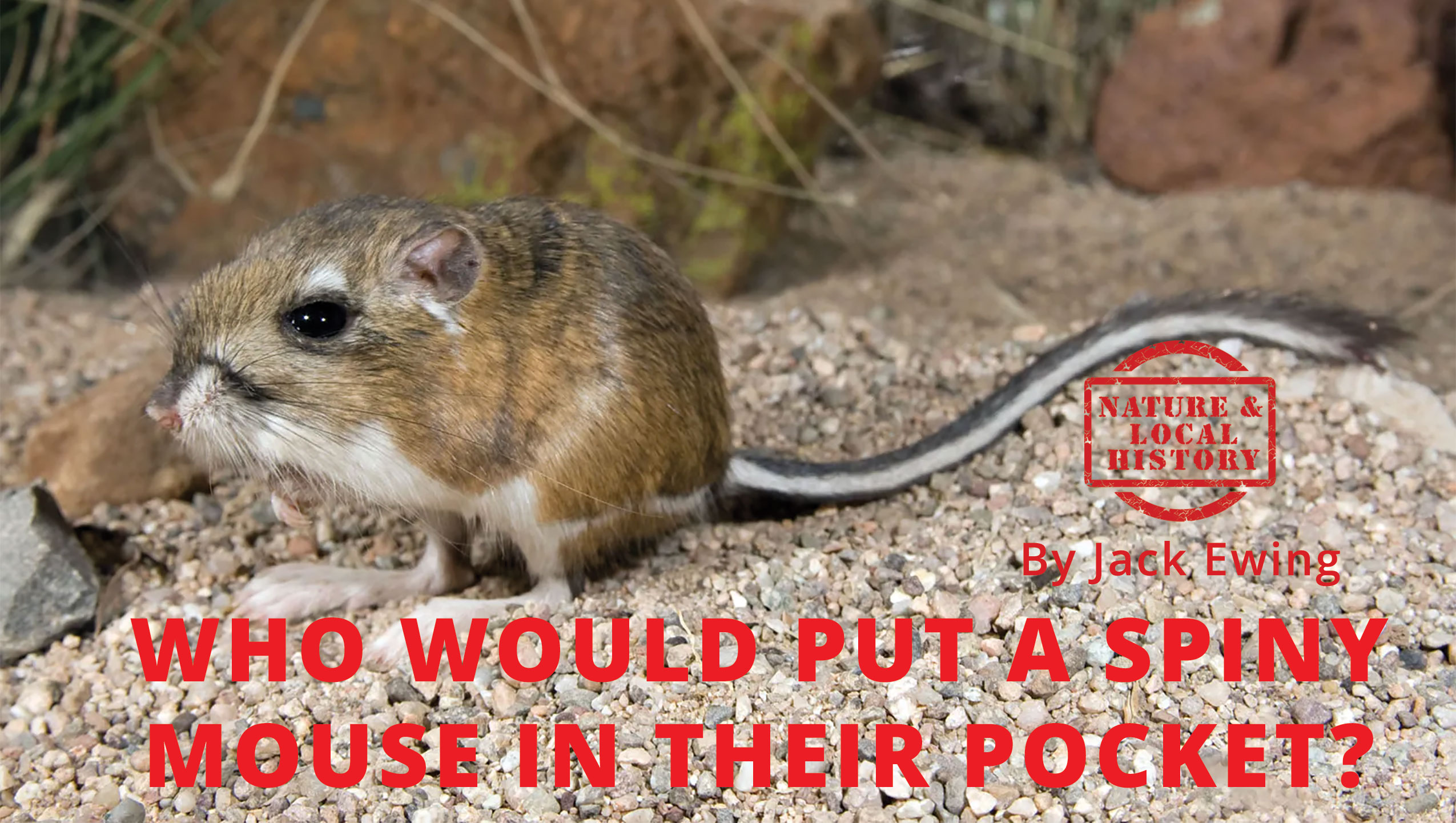Who Would Put a Spiny Mouse in their Pocket?
Occasionally one of my trail cameras captures a photo of a mouse or rat. They are small, difficult to identify, and unexciting. Not at all like a photo of a puma, jaguarundi, tayra, or ocelot. Not long ago, however, one of my cameras captured a series of photos that told the story of a pursuit and capture between an ocelot and a mouse or rat. I knew that rats were one of the ocelot’s favorite foods, and now I had the next best thing to seeing it with my own eyes. It sparked my interest, and I delved into the natural history of the most populous mammals in the world, rats and mice.
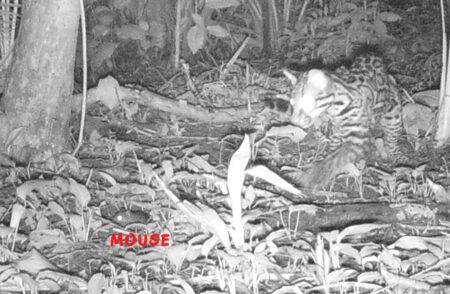 The main difference between the two is size, but according to one source there is another interesting characteristic, mice are curious, and rats are cautious. It is easy to catch mice in traps or entice them into eating poison, but almost impossible to catch a rat or trick it into thinking a tasty poison is good food. We once had a rat that raided our pantry every night. It even ate holes in the heavy-duty plastic containers we used to store rice and other cereal. I found some sticky paper that was guaranteed to catch rats. The paper was very strong, like sandpaper, and the sticky surface was like duct tape sprinkled with Super glue on the sticky side. One evening before going to bed, we laid a sheet of it on a shelf where the rat normally raided food containers. Not long after drifting off to sleep, we were rudely awakened by a horrible racket. I leaped out of bed and ran to the pantry. It was a mess. Pots, pans, and food containers were disheveled and scattered around the floor. The sticky paper was stuck to the edge of the window through which the rat had hurriedly left the scene. The sticky side was full of hair, bits of skin, and the pads from the bottoms of two of the rat’s feet, but no rat. It never returned and apparently spread the word, because none of its buddies ever visited us either. That one unlucky rat’s experience was the last of our rat problem forever. Once was enough. Rats are definitely cautious, and they are also fast learners.
The main difference between the two is size, but according to one source there is another interesting characteristic, mice are curious, and rats are cautious. It is easy to catch mice in traps or entice them into eating poison, but almost impossible to catch a rat or trick it into thinking a tasty poison is good food. We once had a rat that raided our pantry every night. It even ate holes in the heavy-duty plastic containers we used to store rice and other cereal. I found some sticky paper that was guaranteed to catch rats. The paper was very strong, like sandpaper, and the sticky surface was like duct tape sprinkled with Super glue on the sticky side. One evening before going to bed, we laid a sheet of it on a shelf where the rat normally raided food containers. Not long after drifting off to sleep, we were rudely awakened by a horrible racket. I leaped out of bed and ran to the pantry. It was a mess. Pots, pans, and food containers were disheveled and scattered around the floor. The sticky paper was stuck to the edge of the window through which the rat had hurriedly left the scene. The sticky side was full of hair, bits of skin, and the pads from the bottoms of two of the rat’s feet, but no rat. It never returned and apparently spread the word, because none of its buddies ever visited us either. That one unlucky rat’s experience was the last of our rat problem forever. Once was enough. Rats are definitely cautious, and they are also fast learners.
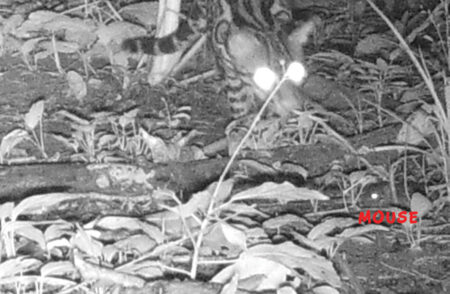 The trail camera I mentioned at the beginning of this article captured a series of photos showing an ocelot stalking a rat or mouse and catching it. The camera was programmed to take a set of three photos one second apart, wait 15 seconds, and take another burst of three. Altogether there were 21 photos taken between 1:40 a.m. and 1:49 a.m. There were two ocelots, one adult, and one nearly grown cub. Each caught at least one rat. I was unable to identify the species of the prey, but after studying the images in my excellent field guide, The Mammals of Costa Rica, by Mark Wainwright, I think it was the Forest Spiny Pocket Mouse, which is about 14 cm. long and is found in this part of Costa Rica.
The trail camera I mentioned at the beginning of this article captured a series of photos showing an ocelot stalking a rat or mouse and catching it. The camera was programmed to take a set of three photos one second apart, wait 15 seconds, and take another burst of three. Altogether there were 21 photos taken between 1:40 a.m. and 1:49 a.m. There were two ocelots, one adult, and one nearly grown cub. Each caught at least one rat. I was unable to identify the species of the prey, but after studying the images in my excellent field guide, The Mammals of Costa Rica, by Mark Wainwright, I think it was the Forest Spiny Pocket Mouse, which is about 14 cm. long and is found in this part of Costa Rica.
The name “Forest Spiny Pocket Mouse” doesn’t mean that it has spines like a porcupine. The spines are usually small and soft. They lay flat against the skin and are buried in fur. Even if you did carry the mouse in your pocket while walking through the forest, the spines probably wouldn’t poke your leg. Anyway, they aren’t called “pocket mice” because you carry them in your pocket. The name refers to the fur-covered pockets they have on the outside of each cheek. When the mice find a bunch of seeds they want to horde until a time of scarcity, they stuff them in their cheek pockets and carry them to a hiding place where they are buried until needed.
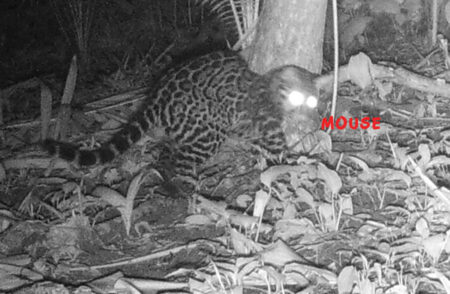 A mouse or rat may seem like very small prey for an ocelot. It seems like it would take a lot of them to satisfy the spotted cat’s hunger. If we take a closer look, it’s really not so strange. The ocelot can and does on occasion kill and eat larger animals. All wild animals need to acquire their food as efficiently as possible. In other words, they need to consume more calories than they expend. Ocelots don’t stalk and chase their prey like some felines. They wait and watch until a mouse or rat walks by, whacks it with a paw, and grabs it between sharp fangs. That system of hunting takes very little energy and the risk of getting hurt is almost nil. But let’s say an ocelot is hungry and decides to try to kill a coati which is roughly half its size. Coatis are fierce fighters that can inflict terrible wounds as anyone whose dog has tangled with one well knows. An ocelot who decides to attempt to kill a coati would have to stalk, chase, catch, and kill it. It would have to expend lots of energy, risk becoming wounded itself, and there is a good chance the coati would get away and all that effort would be for naught. Worse yet; if the ocelot suffers an ugly claw or bite wound, it runs the risk of an infection that might bring its life to a miserable end. Maybe it’s better to stick with rats and mice. Take a good look at the photos of the mouse in the ocelot’s mouth. It looks like a pretty hefty mouthful. Three or four of those in a night would satisfy the feline’s hunger and send it off to slumber with a pleasantly full stomach.
A mouse or rat may seem like very small prey for an ocelot. It seems like it would take a lot of them to satisfy the spotted cat’s hunger. If we take a closer look, it’s really not so strange. The ocelot can and does on occasion kill and eat larger animals. All wild animals need to acquire their food as efficiently as possible. In other words, they need to consume more calories than they expend. Ocelots don’t stalk and chase their prey like some felines. They wait and watch until a mouse or rat walks by, whacks it with a paw, and grabs it between sharp fangs. That system of hunting takes very little energy and the risk of getting hurt is almost nil. But let’s say an ocelot is hungry and decides to try to kill a coati which is roughly half its size. Coatis are fierce fighters that can inflict terrible wounds as anyone whose dog has tangled with one well knows. An ocelot who decides to attempt to kill a coati would have to stalk, chase, catch, and kill it. It would have to expend lots of energy, risk becoming wounded itself, and there is a good chance the coati would get away and all that effort would be for naught. Worse yet; if the ocelot suffers an ugly claw or bite wound, it runs the risk of an infection that might bring its life to a miserable end. Maybe it’s better to stick with rats and mice. Take a good look at the photos of the mouse in the ocelot’s mouth. It looks like a pretty hefty mouthful. Three or four of those in a night would satisfy the feline’s hunger and send it off to slumber with a pleasantly full stomach.
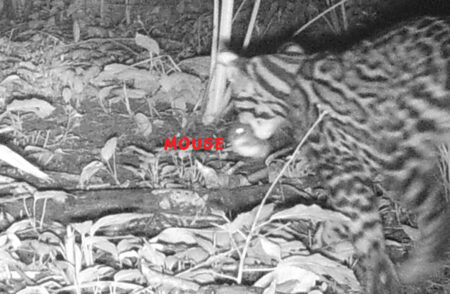 Wainwright’s natural history and field guide tells us that there are about 30 species of mice and rats in Costa Rica, eight of which are found in this part of the country. There are ones like we all know that scurry around on the ground and sometimes sneak into the house, there are arboreal rats, and there are swimming mice. In slightly higher elevations, there is even a singing mouse. I imagine that there are more, but they just haven’t been caught, identified, and studied yet.
Wainwright’s natural history and field guide tells us that there are about 30 species of mice and rats in Costa Rica, eight of which are found in this part of the country. There are ones like we all know that scurry around on the ground and sometimes sneak into the house, there are arboreal rats, and there are swimming mice. In slightly higher elevations, there is even a singing mouse. I imagine that there are more, but they just haven’t been caught, identified, and studied yet.
Jack Ewing was born and educated in Colorado. In 1970 he and his wife Diane moved to the jungles of Costa Rica where they raised two children, Natalie and Chris. A newfound fascination with the rainforest was responsible for his transformation from cattle rancher into environmentalist and naturalist. His many years of living in the rainforest have rendered a multitude of personal experiences, many of which are recounted in his published collection of essays, Monkeys are Made of Chocolate. His latest book is, Where Jaguars & Tapirs Once Roamed: Ever-evolving Costa Rica.

